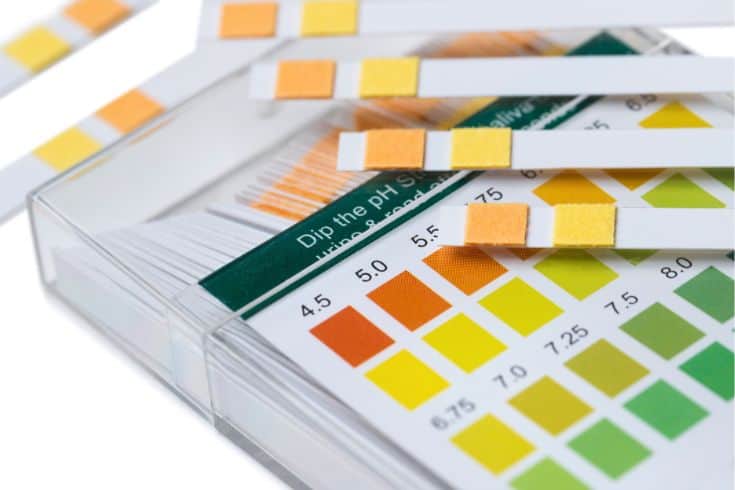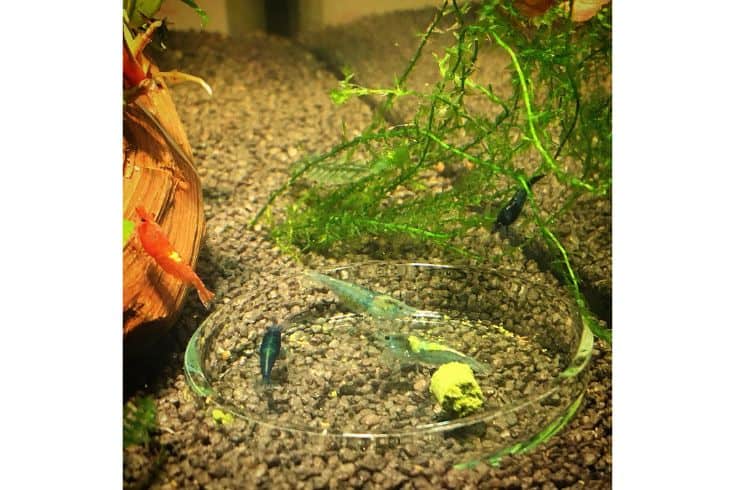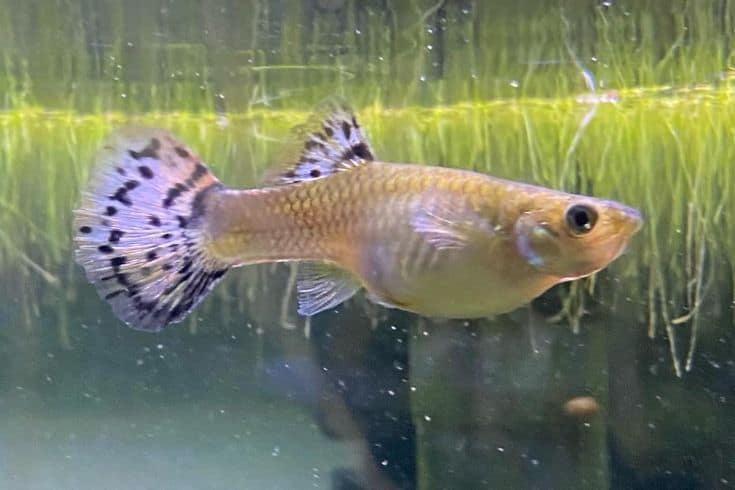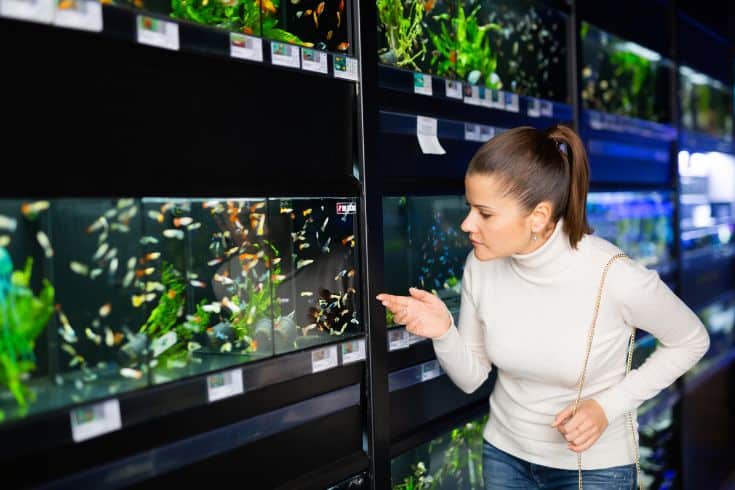Guppies are one of the most popular aquarium fish for both beginners and experienced aquarists alike, but even these hardy creatures can experience issues from time to time. One of the most common problems is guppies laying at the bottom of their tank – a behavior that may indicate disease, poor water quality, stress, or pregnancy.
In this article, we will explain some possible causes of guppies lying on the bottom of the tank, as well as some tips to help prevent it from happening in the future. Read on for more information about why your guppies may be laying at the bottom of their tank – and what you can do about it!
Why Are My Guppies Laying On The Bottom of the Tank?
Disease and Illnesses
The first, and most common cause of guppies laying at the bottom of the tank is due to a disease or illness. Common illnesses in guppies include bacterial infections, parasitic infections, and even swim bladder disorders. Despite the fact that these are common illnesses, they are all debilitating and potentially deadly conditions that may result in very sick fish.
Not every illness comes with obvious symptoms (think glaringly obvious white spots associated with fungal infections.) Instead, the most common signs of disease in guppies are more subtle and include appetite loss, abnormal swimming patterns, and yes, lethargy – which may cause your fish to lay at the bottom of the tank. Hiding behavior is another sign that your guppy may be ill.
If you suspect your guppy is ill, place it in a hospital tank and administer the proper medications for the specific illness. This should be done immediately, and your guppy should be closely monitored for any changes in behavior or health. Even hardy fish like guppies need proper care to stay healthy! And as a general rule, it’s always best to practice preventative maintenance by ensuring good water quality.
Suboptimal Water Parameters

Bad water quality doesn’t just look bad – it stresses your fish out and renders it unable to regulate its internal organs properly. This can cause several issues, including lethargy, making your fish lay at the bottom of the tank. Guppies exposed to high ammonia levels are especially prone to this problem, as are fish kept in water that doesn’t match their preferred water parameters.
To keep your guppies from getting sick, it’s important to perform frequent water changes, and provide adequate space for your tank inhabitants. Guppies generally require at least 2 gallons of water per fish, which means, for example, a 10-gallon tank should not house more than 5 guppies. Both measures keep your water clean by ensuring that there’s always fresh water to process ammonia and other toxins.
You should also monitor your water temperature diligently. Like most tropical fish, guppies thrive in warm water between 72 and 82 degrees Fahrenheit. When they are kept in cold water, they can become sluggish and listless, and may end up lying at the bottom of the tank. You don’t need numerous heaters to keep the tank temperature stable; an adjustable heater can do the job just fine.
Stress
Guppies are sensitive creatures and may lay at the bottom of the tank if they feel overly stressed. Stress can be caused by a variety of factors, such as aggressive tank mates, poor water quality, or an overcrowded tank. Your guppies can also become stressed if they are kept in unideal conditions, or exposed to sudden changes in water parameters (e.g., pH, hardness etc.).
To prevent stress-related issues from occurring, it’s best to ensure that your guppy tank is properly stocked with compatible tank mates, and that it is kept clean at all times. If your guppies are kept in community tanks, keep an eye out for any signs of aggression, such as chasing or nipping. Separate the aggressors if necessary, and provide plenty of hiding spots for any fish feeling intimidated or stressed.

Generally speaking, stress-related symptoms should disappear once the issue is addressed. However, the signs of stress can also be very subtle. To ensure that you catch any issues before they become serious, it’s best to watch your fish carefully and monitor their behavior. Pay attention to any changes in your fish’s behavior, and act quickly if you notice any abnormal behavior or signs of stress.
Suffocation/Oxygen Deprivation
Your guppies may also be lying at the bottom of the tank due to suffocation or oxygen deprivation. This can happen if there is insufficient air circulation in your tank, as guppies need sufficient oxygen levels in the water to survive. Poor water quality, overcrowding, and high levels of organic waste can all reduce the amount of available dissolved oxygen, making it difficult for your fish to breathe properly.
To prevent this issue from occurring, always make sure that you have a reliable air pump running in your aquarium. Ensure that the pump is powerful enough to provide adequate air circulation throughout the tank, and that it’s placed somewhere near a filter outlet where water movement can help dissolve oxygen into the water. Air stones can also help increase the oxygen levels in your tank.
In addition, make sure that you don’t overstock your tank. Guppies are naturally active fish, and need plenty of space to move around in order to stay healthy. Finally, keep an eye on the water quality levels in your tank. You should have a good filtration system to begin with, and perform regular water changes to keep the tank clean and free of organic waste.
Pregnancy
Guppies that are pregnant and close to giving birth may also lie at the bottom of the tank. This is one of the most common reasons for this behavior, as female guppies will often seek shelter at the bottom of the tank before giving birth. This is especially true if there are other fish in the tank, as pregnant females may feel threatened or intimidated by them.

To confirm your suspicions, try looking for your guppy’s gravid spot. This is a dark spot that appears near the guppy’s vent when she is carrying fry. If you see this spot, it means your guppy is pregnant and preparing to give birth. An enlarged abdomen is also a sign of pregnancy, particularly if the female guppy is already mature and has reached breeding age.
If your guppy is pregnant, it’s best to move her into a separate tank before she gives birth. This ensures that any newborn fry will have a safe place to hide from predators until they are old enough to fend for themselves. You should also remove the mother guppy from the tank shortly after she gives birth, as she may become aggressive towards her fry and try to eat them.
What To Do When Guppies Lie On The Bottom Of The Tank
Test Your Water
If you notice your guppies lying at the bottom of the tank, it’s best to test your water parameters first. Check for any signs of ammonia or nitrite poisoning, as both can be deadly if not addressed immediately. It’s also important to check your tank’s temperature and pH levels – guppies prefer warm temperatures between 72-82 degrees Fahrenheit, and slightly alkaline water with a pH between 7.5-8.
It is extremely useful to invest in a good quality test kit. This will help you keep track of your water parameters, and alert you to any issues before they become serious. You should also invest in a good quality aquarium thermometer. Despite the upfront investment, both pieces of equipment are invaluable for keeping your tank inhabitants healthy and happy.
Though we recommend testing your water as often as you can, a good rule of thumb is to test it at least once a week. This ensures that the water parameters remain stable and consistent, which keeps your guppies healthy and active. You should also perform more frequent tests if you’ve changed something in the tank, such as adding a new filter or switching out your water source.
Observe Affected Fish In A Quarantine Tank

Guppies often lie on the tank floor when they’re unwell, or experiencing stress. If you notice any of your guppies exhibiting this behavior, it’s best to separate them from the rest of the tank and move them into a quarantine tank. This allows you to monitor your fish with ease (sick fish tend to hide), and it also protects the rest of your tank from any infectious diseases.
You can think of a quarantine tank as a temporary hospital for sick fish. The tank should be equipped with a low-flow filter, and you should perform frequent water changes to keep the water clean and free of toxins. You’ll also want to make sure that the temperature in the quarantine tank matches that of your main aquarium – guppies need warm temperatures between 72-82 degrees Fahrenheit to stay healthy!
Once you’ve moved your guppy into its own hospital tank, closely monitor it for any changes in behavior or health. If it does not improve within a few days, contact a veterinarian who specializes in aquatic creatures as soon as possible; they may be able to diagnose and treat whatever is causing your fish’s distress more effectively than you could on your own.
Create Additional Hiding Spots
Stress can cause guppies to lie at the bottom of the tank. To prevent this from happening, it’s best to provide plenty of hiding spots throughout your tank – particularly if you have other fish in there as well. Plant-based decorations are especially useful for this purpose, and they also help keep nitrate levels low by providing a source of oxygen for your fish to breathe.
You can also try adding a few floating plants near the surface of your aquarium – these can help calm down stressed out guppies by providing them with some extra shade and shelter from their surroundings. Guppies in indoor tanks don’t typically need overhead protection, but the presence of these floating plants can help make them feel more secure.
In addition to plants, driftwood, rocks, and artificial décor can also be used to create hiding spots. Remember, the more places your guppies have to hide, the less stressed they will feel! Just make sure that you don’t overcrowd your tank with decorations – too many objects can lead to nitrate build-up and make it difficult for your fish to swim around freely.
Final Thoughts
Guppies laying at the bottom of the tank can be a sign of illness, poor water quality, or stress. In some cases, it may also be caused by pregnancy or suffocation/oxygen deprivation. No matter what the cause is, it’s important to look out for any signs of distress in your fish – and act quickly if you notice them. Timely intervention can make a world of difference!
We hope that these tips have been helpful. Remember, the key to a healthy aquarium is regular water changes and careful monitoring. If you practice preventative maintenance by keeping your water clean, you should be able to keep your guppies healthy and happy. Thanks for reading, and do share this article with anyone who owns a guppy tank!
